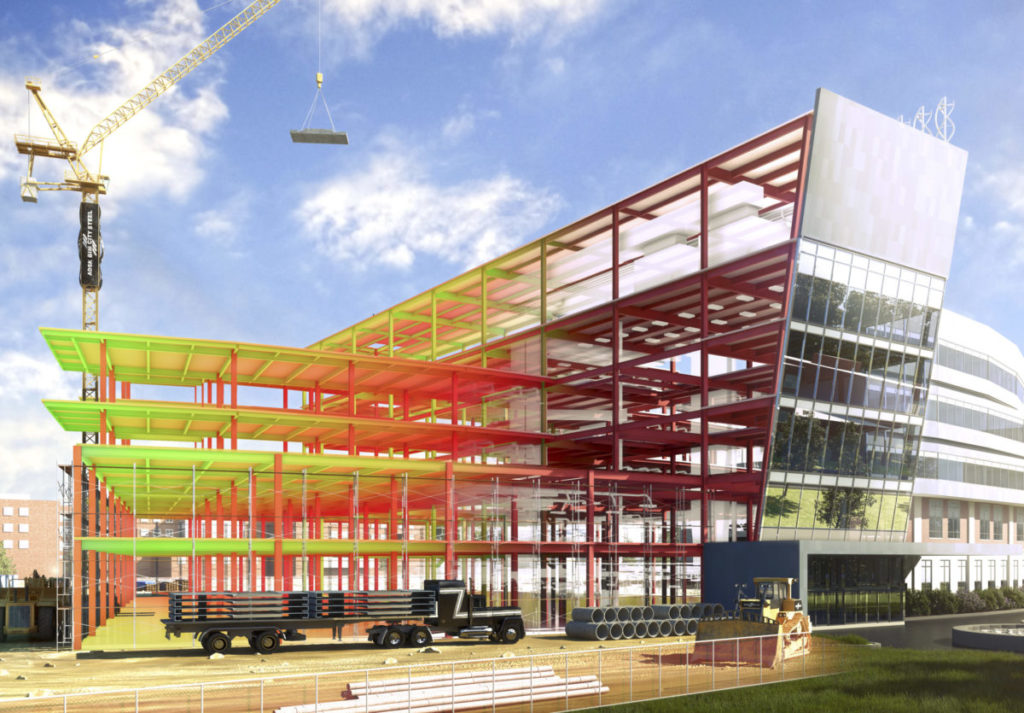Growing Your Architecture Firm with BIM
By Elizabeth Crofton | BIM
Grow with BIM
Whether their architecture firm has adopted Building Information Modeling (BIM) or not, most firm leaders understand that the BIM process has changed the way buildings are planned, designed, constructed, and operated. The impact of BIM on projects is measurable, with project timescales reduced by as much as 15 percent. But BIM also shows in the bottom lines of firms—helping them to grow and thrive. A report from Dodge Data and Analytics determined that 65 percent of architects using BIM found that it delivered a positive ROI, with high engagement with the process correlating with higher levels of return.
But what is BIM? With BIM, design teams develop an intelligent, 3D model of their project that lets them gain a deeper understanding of how a building will perform as they work. Architects and engineers who use BIM get more done in less time thanks to connected, interoperable workflows and more efficient analysis, collaboration, and visualization. In contrast, CAD-based 2D designs lack the intelligence that enables the efficiency and quality gains seen in the BIM process.
This article takes you through the business benefits of BIM, showing how firms like yours have turned new capabilities into opportunities. You’ll learn about the ways that BIM can make your business stronger and more competitive.
Make BIM a catalyst for growth—and increased profitability.
Full or barely BIM?
Architecture firms have implemented BIM to varying degrees. Some start with simply modeling their designs in 3D instead of drafting them in 2D. Working in 3D allows them to better visualize their designs, supporting improved decision-making. They also automatically generate construction documents as an output of the model, speeding the documentation process dramatically.
But firms seeing the most benefits go much deeper than just visualization and documentation creation. They rely on BIM to improve coordination with MEP and structural design models, drive multidisciplinary collaboration, and expand their scope of services. When BIM touches the whole project—and everyone on the extended team—you save time, increase quality, and reduce risk even more than with limited approaches.
BIM for All
BIM is more entrenched in large firms as compared to smaller ones—you might almost think that the “B” in BIM stands for “big.” While smaller firms have historically trailed larger firms in moving away from CAD-based workflows, proven benefits to the bottom line have contributed to BIM being widely considered the new standard of practice among architecture firms of all sizes.
Some leaders at smaller firms may not think that the benefits of BIM, such as time savings and error reduction, will make up for the learning curve and adoption costs. Not so. Fewer errors and task automation can help offset some of the adoption efforts and provide an early taste of the profitability-enhancing productivity gains that come with BIM experience.
But it’s the long-term business value of BIM that firms of every size need to consider. Clients want their projects to enjoy the benefits of BIM. These satisfied clients lead to more repeat business and referrals. BIM also helps firms collaborate better and more quickly with consultants, which can enhance margins. And the capabilities that BIM enables let firms of every size expand the number of billable services offered. Just as importantly, smaller firms that use BIM will not be at a disadvantage when competing for work against firms that have adopted BIM.
The State of BIM Adoption in North America
As of 2012, 70 percent of architects in North America surveyed by Dodge Data and Analytics report that they have adopted BIM in some form. But an AIA survey reveals that smaller firms lag larger firms in their rates of BIM adoption. Among one-person firms, a mere 22 percent use BIM, and just 37 percent of firms with fewer than nine employees use BIM. The picture looks different at the other end of the scale. By 2013, more than 80 percent of firms with more than 50 employees used BIM, and more than 60 percent of firms with between 10 and 49 employees had also turned to BIM.
Win More Work
Winning work is the cornerstone of success. For architecture firms, winning work, especially from new clients, typically means success in a competitive bidding process. BIM can help you stand out when you pitch your firm to clients. Your peers— and competitors—are already using BIM to win work, with 49 percent of architects reporting that marketing new business is a top benefit of BIM.
The time savings and quality gains of BIM translate directly into value for clients. All clients want their projects to progress on schedule, and they definitely want a quality outcome. Explain to clients how the accurate BIM model supports those goals. The model lets you reduce the risk of clashes and streamlines collaboration. It also contributes to more accurate scheduling, project planning, and budget estimation. And here’s a win every owner wants: fewer change orders. A study by the firm of J.C. Cannistraro found that collaborative BIM led to a dramatic drop in change orders.
You’ll also be able to wow clients—especially those new to BIM—with realistic visualizations. Explain to potential clients that, during the design process, visualizations will help you communicate design intent and help them make more informed decisions. BIM visualizations will help you reduce the risk that your client’s expectations will be incongruent with reality. And better-informed clients are happier, easier-to-manage clients.
Why owners want BIM
With BIM, your clients get a more accurate view of their projects—from start to finish. Owners who’ve experienced BIM appreciate what it does for them. A 2015 SmartMarket report from Dodge Data & Analytics includes survey data that captures owners’ opinions of BIM.
“We’ve seen that during design that as many as 1,200 meaningful clashes were resolved before even the 100 percent CD (construction documentation) mark.”
Shrimant Jaruhar | Northwestern Memorial Hospital
Keep the Clients You Win
After you win clients, you want to keep them. Among BIM users, 49 percent perceived that BIM helps achieve exactly that goal. It’s easy to understand why. Once owners experience the benefits you can deliver with BIM, they’re going to be reluctant to seek design help elsewhere. They’re also more likely to refer peers to your firm.
Clients approach projects with high-quality expectations. When outcomes fail to meet those expectations, they’re not likely to turn into repeat business. Of owners that use BIM on projects, a sky-high 93 percent feel that their projects meet their quality expectations. That same percentage of owners—93 percent—found that BIM actually improved the quality/function of the final design. For owners, time is money, and nearly half of owners found that BIM accelerated project completion by at least 5 percent.
“BIM has changed the industry because, when used well, it leads to better buildings and better results for clients. We’ve been able to share BIM with clients and show them why it matters. BIM means fewer surprises in the field, better collaboration, and increased efficiency.”
Ruth Baleiko | Principal, Miller Hull Partnership
Produce Higher Quality Work
When you follow a BIM process, you develop an intelligent building model. That intelligence not only gives insight into how the building will perform, it lets you make changes more quickly and easily. The combination of deeper understanding and speed proves powerful as you refine your designs. Of architects that use BIM, 74 percent found that BIM improved project outcomes, and 89 percent reported that BIM improved the quality of the final design.
Whereas with a 2D process you might explore just a few options, BIM makes it easy to explore dozens—or even infinite possibilities as you connect to more tools. Not sure of the best siting option? Tweak the position of the building iteratively. See how small and large changes affect factors like lighting. You can employ that same exploration as you make virtually every design decision.
The 3D visualizations that are essential to the BIM process can also help you include more and better input from the client team. For instance, if you’re designing nursing stations at a hospital, show the actual nurses the designs and get their feedback. They’ll be able to easily visualize how the stations will look. The end result is a building designed with more understanding of how each choice contributes to a better outcome.
Start Improving Quality Now
Getting started with BIM requires a few things. You’ll need BIM software, an implementation plan, and a commitment from firm leaders like you. Contact us for resources to help you start realizing the benefits of BIM. The shift does require an investment in time and resources, but the payoff may be just three projects away. The Growth Through BIM report from the Construction Industry Council says:
“Firms typically need three BIM-based projects under their belt before they can outperform previous practice.”
Work Better with Consultants
You’ll find that BIM powers smoother collaboration with consultants. Together, you and your multidisciplinary project teams design using the same model. Everyone sees each other’s work and accounts for it as they design. You coordinate as you go. Even contractors can join the process, and contribute input on constructability from the earliest stages of the design process.
Architects who use BIM appreciate the results they see from closer collaboration with consultants, with 74 percent of architects finding that BIM leads to better multiparty communication. Among architects sharing and receiving BIM models from consultants, more than 50 percent rated the quality, accuracy, completeness, and usefulness of the models highly. And the quality shows at the construction site: 98 percent of contractors think that BIM improves the constructability of the final design.

“Architecture firms of every size struggle with margins. BIM offers new avenues to improve profitability. Completing tasks faster helps, but the increased insight and control you see with the BIM process opens the door to an even larger opportunity. Firms that master BIM will find that they can begin to charge both for design work and for realizing agreed upon outcomes, such as design time or construction cost.”
Phil Bernstein | Associate Dean, Yale University
Offer New Billable Services
Do more and your business grows. Winning new work and repeat clients are only the beginning. BIM lets you expand the scope of services you offer to all your clients. How? You harness the power of the intelligence within your building model—just like the 48 percent of architects who have used BIM to help them offer new services. With BIM, you can readily offer services that you may be sent to outside consultants today. Take energy analysis as an example. You can analyze the energy use of your proposed design within BIM design tools or turn to specialty energy analysis tools that work with your model. You can also leverage models in the fabrication process, helping you bring a formerly outsourced process in-house.
Do your clients ever need photorealistic renderings to share with stakeholders or the public? Create them yourself from your design model. These same sophisticated models can later play a role in your sales process, helping you wow clients with past results.

As projects wind down, offer to provide clients with an as-built record model of the building. These models help your clients operate and maintain their buildings more efficiently. Of architects that use BIM, 45 percent report that they frequently deliver an as-built record model. These as-built models can be an ongoing source of work, with your firm helping the owner keep the model current as the building changes.
Operate More Efficiently
Some of the earliest adopters of BIM were attracted to the potential efficiency benefits. The intelligence of the BIM process made it easier for them to spot— and even avoid—errors and omissions. And the fact that changes rippled through the model automatically saved substantial time by eliminating many tedious tasks. For architects, these everyday BIM benefits lead to business value, especially for firms that do work on fixed fees. Time saved translates directly into enhanced margins, and fewer errors lead to reduced risk and rework.
Operational pluses rank highly among architects asked about the advantages of BIM, with 57 percent of architects citing reduced errors and omissions as a top benefit of BIM. Another 45 percent cite reduced rework as a top benefit, and 68 percent of architects found that BIM helped them reduce time on project activities and delivery.
As BIM has evolved, the efficiency advantages have only gained momentum. Today’s interoperable technologies reduce the need to remodel to work with preferred applications. And cloud-based services make it even easier and faster to share information across extended project teams.
Start your move to BIM
See how BIM can help your firm realize all the business wins discussed in this article. Contact us to learn more about transitioning to a process that can help you operate more efficiently, win new business, and deliver higher-quality work.
INDUSTRIES: Architecture, Buildings, Civil Engineering, Civil Infrastructure, Construction, MEP Engineering, Structural Engineering








